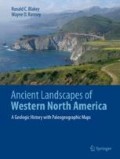Abstract
With the amalgamation and assembly of Pangaea in the late Paleozoic, a hypothetical visitor could have traveled entirely by land from the western edge of the supercontinent in Nevada, across Laurentia and the Appalachian crest, to the plains of Eastern Europe, across the Ural Mountains in Russia, and then southward through Africa, India, Australia, and Antarctica (Fig. 6.1). The equator now trended from just south of Arizona through Texas, North Carolina, on to Algeria and out to the Paleo-Tethys Sea, a part of the Panthalassa Ocean.
Author information
Authors and Affiliations
Rights and permissions
Copyright information
© 2018 The Author(s)
About this chapter
Cite this chapter
Blakey, R.C., Ranney, W.D. (2018). The Amalgamation of Pangaea and the Sonoma Orogeny: Early Permian to Early Triassic – Ca. 300–240 Ma. In: Ancient Landscapes of Western North America. Springer, Cham. https://doi.org/10.1007/978-3-319-59636-5_6
Download citation
DOI: https://doi.org/10.1007/978-3-319-59636-5_6
Published:
Publisher Name: Springer, Cham
Print ISBN: 978-3-319-59634-1
Online ISBN: 978-3-319-59636-5
eBook Packages: Earth and Environmental ScienceEarth and Environmental Science (R0)

